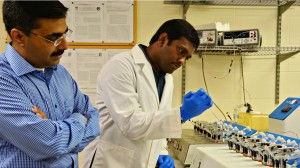
S. Narasimha Murthy (left) observes graduate student Abhishek Juluri as they conduct research on cyclodextrin derivatives.
OXFORD, Miss. – University of Mississippi School of Pharmacy researchers are studying an improved method for delivering drugs that treat pain and inflammation.
- Narasimha Murthy, associate professor of pharmaceutics, and Abhishek Juluri, a pharmaceutics doctoral student, are pursuing new compounds that enable easier drug delivery through the skin. Their work is supported by a collaborative agreement with Ligand Pharmaceuticals Inc.
The project centers on a patented cyclodextrin derivative supplied by Ligand. Cyclodextrins are cyclic carbohydrates with a “bucket-like cavity” within the molecules, Murthy said.
“They entrap water-insoluble drug molecules in the cavity and render them soluble in water,” he said. “The cyclodextrin derivatives we are using are prepared with multiple charges that enhance the transport of water-insoluble drugs.”
Murthy said that Ligand’s cyclodextrin derivatives can help highly lipophilic drugs such as steroids, anti-inflammatory drugs and antilipidemics (lipid- or fat-reducing drugs), which tend to remain in tissue, enter the circulatory system more effectively through the skin.
“Presently, there are no permeation enhancers to address this issue efficiently,” said Juluri, who is using the project for his dissertation. “I’m excited that Ligand’s unique cyclodextrin derivative could overcome this issue.”
Murthy said that utilizing cyclodextrin derivatives for dermal and transdermal delivery could have numerous applications.
“We would like to continue to explore the mechanisms associated with this phenomenon, as well as the potential of cyclodextrin derivatives in delivering drugs used to treat arthritis, infections and metabolic disorders,” he said.
Juluri and Murthy have already seen promising outcomes. Their work on Ligand’s cyclodextrin derivative Captisol, for example, was recently published in the Journal of Controlled Release.
According to Ligand, Captisol is a patent-protected, chemically modified cyclodextrin with a structure designed to optimize the solubility and stability of drugs. The original form of Captisol was invented and initially developed by scientists in the laboratories of Valentino Stella at the University of Kansas Higuchi Biosciences Center for use in drug development and formulation.
This unique technology has enabled six Food and Drug Administration-approved products, including Onyx Pharmaceuticals’ (now a subsidiary of Amgen) Kyprolis, Baxter International’s Nexterone and Merck’s NOXAFIL IV. Also, more than 30 Captisol-enabled products are in clinical development.
“Our results show that an anesthetic drug, propofol, could be delivered in therapeutically significant amounts into the circulatory system to elicit mild sedation and anesthesia,” Juluri said. “We hope to develop a delivery system that would be useful in noninvasive induction and maintenance of anesthesia in pediatric patients.”
For the two Ole Miss researchers, next steps include developing topical drug formulations to be evaluated in animal models, Murthy said.
The collaborative agreement is in effect until March 2015.